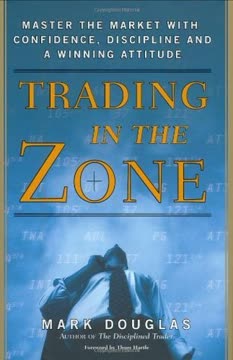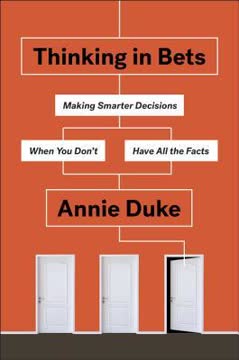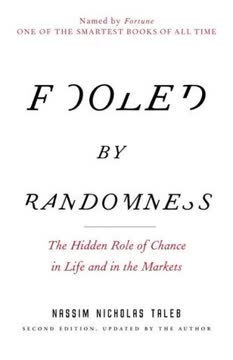Key Takeaways
1. Markets are continuous two-way auctions driven by timeframe imbalances
It is imbalance between the timeframes that drives the auction process.
Auction process fundamentals. Markets function as continuous auctions, with prices moving up and down as buyers and sellers interact. The key insight is that participants operate in different timeframes - day, short-term, intermediate-term, and long-term. These timeframes have different behaviors and expectations, creating imbalances that drive price movement.
Timeframe interactions. Longer timeframes often transact with shorter "weaker hands" that are less committed to holding inventory. This can lead to inventory imbalances in shorter timeframes, resulting in phenomena like short-covering rallies or long-liquidation breaks. Understanding these dynamics is crucial for anticipating market movements and identifying trading opportunities.
Diffusion of information. Market participants react to information at different speeds, similar to the diffusion model of innovation adoption. This concept helps explain how trends develop and reverse:
- Innovators act first on new information
- Early adopters follow
- Early and late majority join as trends become established
- Laggards finally act, often signaling the end of a trend
2. The Market Profile organizes auction data to reveal structural patterns
The Market Profile served as an innovative way to organize these continual two-way auctions in such a way that specific participant behavior could sometimes be visualized.
Beyond price data. The Market Profile is a powerful tool that organizes market data to reveal structural patterns not visible in traditional price charts. It plots time on the horizontal axis and price on the vertical axis, creating a distribution that shows where the market spent the most time trading.
Key structural elements:
- Point of Control (POC): The price level with the most activity, representing the "fairest" price
- Value Area: The range where 70% of trading occurred
- Single Print Areas: Prices quickly rejected by the market
- Balance Areas: Regions of two-sided trade
- Excess: Price levels that extend beyond normal distribution, often signaling potential reversals
Interpreting structure. By learning to read these structural elements, traders can gain insights into market sentiment, potential support/resistance levels, and directional conviction. This provides a significant edge over traders relying solely on price action.
3. Successful trading requires both market understanding and self-understanding
Once they've gained market understanding, at least 75 percent of their results are based upon self-understanding.
Dual focus for success. While developing a deep understanding of market mechanics is crucial, it's only part of the equation. Equally important is developing self-awareness of your own psychological tendencies, biases, and emotional reactions to market movements.
Key aspects of self-understanding:
- Recognizing your risk tolerance
- Identifying emotional triggers that lead to poor decisions
- Understanding your natural cognitive biases
- Developing the discipline to follow your trading plan
- Cultivating the patience to wait for high-probability setups
Continuous improvement. Both market understanding and self-understanding require ongoing effort and reflection. Keeping a detailed trading journal can help identify patterns in your decision-making and emotional responses, allowing you to refine your approach over time.
4. Preparation and visualization are crucial for effective trading
Traders who don't prepare, or don't know how to prepare, are generally at a serious disadvantage.
Pre-market routine. Successful traders develop a consistent pre-market routine to prepare for the trading day. This typically involves:
- Reviewing longer-term charts (monthly, weekly, daily) for context
- Identifying key support/resistance levels and potential catalysts
- Developing multiple scenarios for how the day might unfold
- Setting specific entry and exit criteria for potential trades
Visualizing scenarios. Mental rehearsal is a powerful tool used by elite performers in many fields, including trading. By visualizing different market scenarios and your planned responses, you can improve your ability to react calmly and decisively when those situations arise in real-time.
Overnight inventory analysis. Understanding the positioning of overnight traders can provide valuable insights into potential early market moves. Assessing whether overnight inventory is long, short, or neutral helps anticipate possible inventory adjustments at the market open.
5. Focus on context and odds rather than just price movements
Traders are prone to overestimating how much they understand about the market by looking at price, and becoming overconfident by the illusion of certainty.
Beyond price action. While price is the most visible aspect of market activity, focusing solely on price movements can lead to poor decision-making. Successful traders consider a broader context, including:
- Volume and its relationship to price moves
- Market structure as revealed by the Market Profile
- Sentiment indicators and positioning data
- Intermarket relationships and correlations
Probability-based decisions. Instead of trying to predict exact price movements, think in terms of probabilities and risk/reward ratios. This approach helps manage risk and avoids the trap of overconfidence based on recent price action.
Avoiding tunnel vision. Be aware of the tendency to fixate on recent price movements or a single piece of information. Constantly challenge your assumptions and seek out information that might contradict your current view of the market.
6. Recognize and exploit excess, balance, and inventory imbalances
The two most important concepts we deal with are excess and balance.
Excess signals change. Excess occurs when the market moves too far in one direction, creating unsustainable conditions. This can manifest as:
- Price gaps
- Single print areas in the Market Profile
- Extreme sentiment readings
Recognizing excess helps identify potential turning points and opportunities for mean reversion trades.
Balance precedes breakouts. Periods of balance, where the market trades in a narrow range, often precede significant moves. Key balance formations include:
- Inside days on daily charts
- Overlapping value areas in the Market Profile
- Narrowing Bollinger Bands
Traders can prepare for potential breakouts by identifying these balance areas.
Inventory imbalances create opportunity. When market participants become too heavily positioned in one direction, it creates the potential for sharp reversals. Signs of inventory imbalances include:
- Extremely one-sided sentiment readings
- Large speculative positions in COT reports
- Elongated Market Profile structures
These situations often lead to short-covering rallies or long-liquidation breaks.
7. Evolve from competent to expert by internalizing market behavior
To progress beyond the average, beyond the middle of the bell curve and into the upper extremes of excellence, you must achieve self-understanding.
Stages of skill acquisition:
- Novice: Learning basic rules and concepts
- Advanced Beginner: Applying rules in context
- Competent: Developing a holistic view of the market
- Proficient: Intuitive understanding of market behavior
- Expert: Effortless integration of knowledge and intuition
From rules to intuition. As traders progress, they move from rigidly following rules to developing an intuitive feel for the market. This comes through extensive experience and reflection on market behavior.
Continuous learning. Even expert traders never stop learning. The market is constantly evolving, requiring ongoing adaptation and refinement of trading approaches. Embrace a growth mindset and view each trading day as an opportunity to deepen your understanding.
8. Develop a comprehensive business strategy for consistent trading success
Trading is a business. It involves the same tangible and intangible elements of any business strategy.
Key business elements:
- Capital management: Ensure adequate capitalization and risk control
- Information management: Develop reliable sources and filter out noise
- Inventory management: Skillfully manage positions and risk exposure
- Performance tracking: Keep detailed records to evaluate and improve
- Competitive analysis: Understand the behavior of other market participants
Strategic planning. Develop a clear trading plan that outlines your:
- Overall market approach and philosophy
- Specific strategies for different market conditions
- Risk management rules and position sizing guidelines
- Performance goals and evaluation metrics
Consistency and discipline. Treat trading as a serious business venture, not a hobby or gambling activity. This mindset promotes the discipline required for long-term success.
9. Balance analytical and intuitive thinking as a "whole-brained" trader
By understanding both and being able to use the correct hemisphere for the correct task, we can be more whole brained and effective in our decision-making.
Left-brain strengths:
- Analytical thinking
- Rule-based decision making
- Logical sequencing of information
Right-brain strengths:
- Pattern recognition
- Intuitive insights
- Holistic market view
Integrating both hemispheres. Successful traders learn to leverage both analytical and intuitive thinking. Use left-brain analysis for preparation and strategy development, then engage more right-brain intuition during actual trading sessions.
Developing intuition. Market intuition isn't mystical; it's the result of internalizing vast amounts of market experience. Cultivate this by:
- Studying historical market behavior
- Practicing real-time market observation without trading
- Reflecting on your trades to identify subtle patterns
10. Learn to identify and capitalize on market-created opportunities
Special Situations are not fail-safe answers, but they do offer a trader some degree of comfort and security.
High-probability setups. While no trade is guaranteed, certain market conditions offer higher-probability opportunities. Examples include:
- 3 to I days: When initiative activity aligns in one direction
- Neutral-Extreme days: Potential for follow-through after a directional close
- Value-Area Rule: Probability of price moving through previously established value
- Balance-area breakouts: Potential for sustained moves after periods of consolidation
Recognizing opportunity. Develop the ability to quickly identify these special situations as they develop. This often requires:
- A strong foundation in market structure analysis
- Experience in observing how these patterns play out
- The discipline to act decisively when opportunities arise
Risk management is crucial. Even high-probability setups can fail. Always define your risk and have a clear exit plan before entering any trade, regardless of how compelling the setup appears.
Last updated:
FAQ
What's Mind over Markets about?
- Market Behavior Focus: Mind over Markets by James F. Dalton delves into market behavior through auction market theory, explaining how traders can interpret market-generated information.
- Market Profile Methodology: It introduces the Market Profile, a tool that organizes price and time data to visualize market activity, aiding traders in decision-making.
- Skill Development: The book outlines a progression from novice to expert trader, emphasizing self-understanding as crucial for trading success.
Why should I read Mind over Markets?
- Practical Insights: The book offers practical trading strategies based on market structure and behavior, valuable for both novice and experienced traders.
- Understanding Dynamics: It helps readers grasp the dynamics of market auctions, essential for informed trading decisions.
- Timeless Relevance: Despite its 1990 publication, the principles remain relevant, focusing on fundamental market behavior rather than specific systems.
What are the key takeaways of Mind over Markets?
- Market Profile Importance: The Market Profile is vital for organizing market data, helping traders visualize price movements and understand market sentiment.
- Auction Process Understanding: Recognizing the auction process is crucial for determining trade entry and exit points based on market conditions.
- Self-Understanding in Trading: The book stresses the importance of self-awareness and psychological factors, which significantly impact trading performance.
What is the Market Profile, and how does it work?
- Visual Representation: The Market Profile graphically represents time on the horizontal axis and price on the vertical axis, forming a distribution curve of market activity.
- Identifying Value Areas: It helps traders identify value areas where most trading occurs, gauging market acceptance and potential price movements.
- Dynamic Tool: The Profile evolves throughout the trading day, offering real-time insights into market behavior and participant activity.
What is Auction Market Theory in Mind over Markets?
- Continuous Two-Way Auctions: Auction Market Theory posits that markets operate through continuous two-way auctions, where buyers and sellers interact to determine price.
- Role of Time and Price: The theory emphasizes the relationship between time, price, and volume, suggesting price as a mechanism for advertising opportunity.
- Market Dynamics: It provides insights into market dynamics based on participant behavior, helping traders anticipate changes and adjust strategies.
How does Mind over Markets define "excess"?
- Indication of Reversal: Excess is a price level where the market has moved too far in one direction, indicating a potential reversal.
- Importance in Trading: Recognizing excess can signal the end of a trend and the start of a new auction, aiding in position adjustments and risk management.
- Visual Representation: Excess appears as a significant deviation from the established value area in the Market Profile, highlighting potential trading opportunities.
What is the significance of "balance" in Mind over Markets?
- Market Indecision: Balance indicates a state where the market is not trending, showing indecision among participants and creating opportunities for breakout identification.
- Trading Strategy: Understanding balance helps develop strategies for entering or exiting positions, with breakouts signaling new trends.
- Visualizing Balance: The Market Profile visualizes balance, showing where most trading occurs and guiding decision-making.
What are the different day types discussed in Mind over Markets?
- Normal Day: Characterized by balanced trading with a wide initial balance, where price oscillates without significant directional conviction.
- Trend Day: A day dominated by one side, leading to sustained price movement in one direction, marked by continuous range extension.
- Nontrend Day: Occurs with little directional conviction, often before major news events, with price remaining within a narrow range.
How can I evaluate other timeframe control in the market according to Mind over Markets?
- Tails and Range Extension: Observing tails and range extension in the Market Profile helps identify which timeframe participant is in control.
- Auction Rotations: Monitoring half-hour auction rotations reveals shifts in control and market sentiment throughout the trading day.
- Volume Analysis: Analyzing high and low-volume areas provides insights into market acceptance and potential reversals, indicating control.
What are "composite days" as described in Mind over Markets?
- Definition of Composite Days: Composite days are trading sessions with specific price distributions relative to the day's open, assessing market direction and conviction.
- Types of Composite Days: Includes composite buying days (open in lower range) and selling days (open in upper range), indicating market sentiment.
- Evaluating Directional Performance: Composite analysis helps evaluate directional performance, determining market attempts to move higher or lower.
How does Mind over Markets address the psychological aspects of trading?
- Self-Understanding Emphasis: The book highlights the importance of self-awareness and understanding psychological strengths and weaknesses in trading.
- Decision-Making Under Pressure: It discusses how emotional responses impact trading decisions, offering strategies to manage emotions in high-stress situations.
- Experience as a Teacher: The authors stress that experience is crucial for developing instincts needed to navigate market complexities effectively.
What is the importance of self-understanding in trading, as discussed in Mind over Markets?
- Impact on Trading Performance: Self-understanding influences decision-making and emotional responses, helping develop effective strategies.
- Keeping a Trading Journal: Maintaining a journal tracks thoughts and feelings, identifying patterns and improving self-awareness.
- Balancing Market and Self-Understanding: Successful trading requires balancing market understanding with self-awareness for consistent results.
Review Summary
Mind over Markets receives mostly positive reviews, with readers praising its insights into auction market theory and the Market Profile technique. Many consider it essential reading for traders, offering a unique perspective on market behavior beyond traditional price analysis. Reviewers appreciate the book's depth and psychological aspects of trading. Some note it can be challenging to read and may require multiple passes to fully grasp. While a few critics mention outdated information, most agree it provides valuable foundational knowledge for understanding market dynamics and improving trading strategies.
Similar Books










Download PDF
Download EPUB
.epub digital book format is ideal for reading ebooks on phones, tablets, and e-readers.




